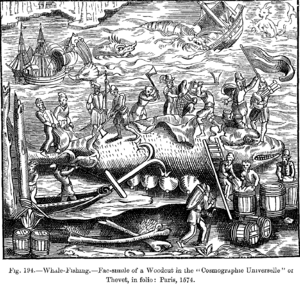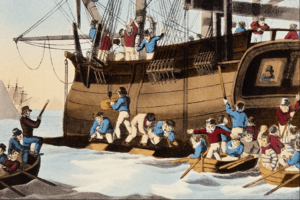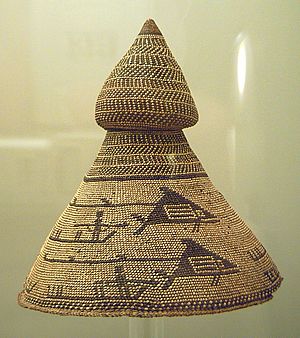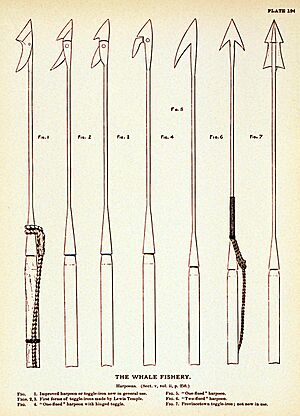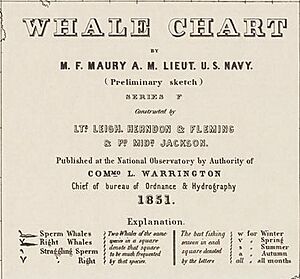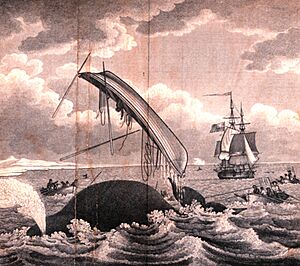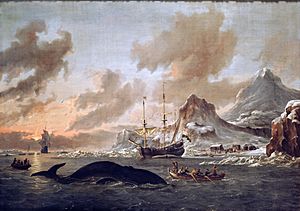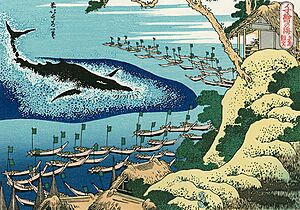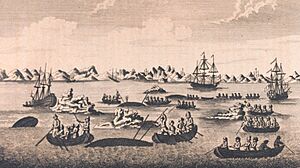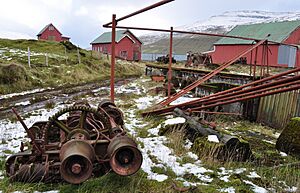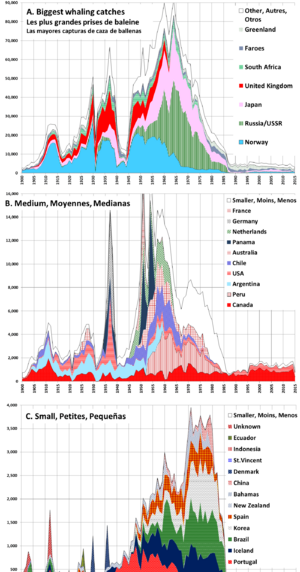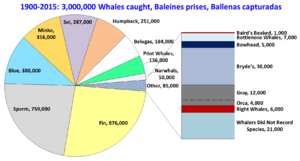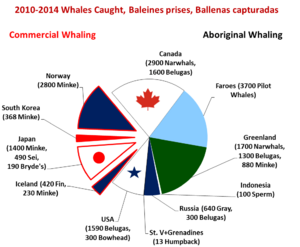History of whaling facts for kids
The history of whaling is all about how people have hunted whales, from ancient times until today. For a long time, hunting whales was super important for many communities. They used whales for food, oil for lamps, and other materials. But as new ways to get oil were found, and as whale numbers dropped a lot, commercial whaling became less common. Still, some countries continue to hunt whales even now.
Contents
Early Whale Hunting
People have been hunting whales for a very, very long time. Some of the oldest pictures of whale hunting might be from 6000 BCE in Korea. That's a long time ago! There's also proof of whaling from around 1000 BCE in Alaska.
One of the first ways to catch whales was called dolphin drive hunting. Small boats would get between the whales and the open sea. Then, they would guide the whales towards the shore, trying to make them get stuck on the beach. This method is still used today for smaller whales like pilot whales and narwhals.
Another old method used a drogue. This was a floating object, like a wooden drum or an inflated sealskin. It was tied to an arrow or a harpoon. Once the harpoon hit a whale, the drogue would make it harder for the whale to swim. The whale would get tired, allowing hunters to get close and kill it. Groups like the Ainu, Inuit, Native Americans, and the Basque people used drogues. Old rock carvings from 6000 BCE show whales surrounded by boats, suggesting they used harpoons and drogues back then. Whale bones found from that time also show how important whales were for food.
There's a chance that people in ancient Rome also hunted whales in the Mediterranean Sea.
Whaling History Around the World
North America
Newfoundland and Labrador
Around the 1520s, people from the Basque Country (a region in Spain and France) started hunting whales and fishing for cod near Newfoundland and Labrador in Canada. Some people even think the Basques found North America before Christopher Columbus because they were chasing whales across the Atlantic Ocean!
The Basques first came to this area for both cod fishing and whaling. Instead of bringing back whale oil, they brought back salted whale meat. By the 1530s, they started building places on shore to process whale blubber into oil. These places were called tryworks.
By the 1540s, Basque whaling trips to Newfoundland were very successful. They sold large amounts of whale oil in Europe. Whale oil was used for lighting lamps. Whale blubber was also used to seal ships and in the textile industry. Whalebone (baleen) was used to make things like knife handles and parts of women's clothing.
Many records from 1548 to 1588 talk about whaling in Red Bay, Newfoundland. This area was important for Basque whalers. The Basques even developed a special language that mixed their own words with Native American words. Whaling in Red Bay ended around 1603.
United States of America
By the 1830s, the United States became the biggest whaling nation in the world. American whaling started in New York and New England, especially in places like Nantucket and New Bedford, Massachusetts. Whale oil was mainly needed for lamps.
Whaling became a very profitable deep-sea business. Trips could last for years, with ships traveling all the way to the South Pacific. During the American Revolution, British ships attacked American whaling ships. Many whalers then became privateers, attacking British ships instead.
After the war, whaling grew again, with Nantucket and New Bedford as major centers. Whalers took bigger risks to find more whales. Thousands of sailors worked on these ships, including many African American sailors. At first, they hunted right whales and humpbacks near the coast. But as these whales became harder to find, they started hunting sperm whales. Sperm whales were especially valuable for spermaceti, a waxy substance that made a very bright flame for lamps. Hunting sperm whales meant longer voyages.
Whale oil was super important for lighting homes and businesses in the 1800s. It also helped machines run smoothly during the Industrial Revolution. Baleen, the long strips of keratin from a whale's mouth, was used to make many products.
The mid-1800s was the best time for American whaling. But after the Civil War, the industry faced problems. Kerosene, a better fuel for lighting, became popular.
Localities
Nantucket and New Bedford were very important whaling towns. Nantucket started whaling in 1690. People would watch for whale spouts from tall masts on the island. Once a whale was seen, rowing boats would go out. If they killed a whale, they would tow it ashore. Workers would then flense (cut off the blubber) the whale. The blubber was boiled in large pots called "try pots" to make oil.
New Bedford became a major whaling port when whaling families from Nantucket moved there. The famous novel Moby-Dick starts with the narrator leaving New Bedford on a whaling voyage.
In the late 1870s, ships started hunting humpbacks in the Gulf of Maine. By 1880, steamers began using bomb lances to hunt fin and humpback whales. This method was called "shoot-and-salvage" because many whales were lost. The first ship to do this was the Mabel Bird. It towed whales to an oil processing plant in Boothbay Harbor. This type of whaling ended in the late 1890s.
Technological Advancement
In the 1850s, whalers tried to catch larger whales like blue whales and fin whales. In the 1860s, Captain Thomas Welcome Roys invented a rocket harpoon. This was a big step for whaling in California. In 1877, John Nelson Fletcher and Robert L. Suits improved Roys' rocket, calling it the "California Whaling Rocket." It was very good at killing whales.
Other countries also copied Roys' rocket harpoon. Danish and Dutch companies used similar inventions in the late 1860s and early 1870s.
Legacy
In 1996, the New Bedford Whaling National Historical Park was created. It has exhibits about the city's whaling history, which was once known as the "City that Lit the World."
Pacific Northwest
Whaling on the Pacific Northwest Coast includes both traditional hunting by native peoples and commercial whaling. Native peoples in this area have hunted whales for thousands of years. Whale meat and oil were very important for their food and culture. Whaling was a big part of the lives of the Nuu-chah-nulth, Makah, and Klallam peoples. Whales also appear as important symbols, like totems, for groups such as the Haida.
Today, Alaska Natives still hunt whales like belugas and bowheads for their own use. The Makah also hunt gray whales. Commercial whaling in British Columbia and southeast Alaska stopped in the late 1960s.
Basque Country (Spain and France)
The first time Basque whaling was mentioned was in 1059, in the town of Bayonne. By 1150, whaling had spread to the Spanish Basque Country. They first hunted the North Atlantic right whale. They used watchtowers, called vigias, to spot the whales' unique two-part spouts.
By the 1300s, Basque whalers were taking seasonal trips to the English Channel and Ireland. In the 1500s, they went to Newfoundland and Labrador, and by the early 1600s, they were in Iceland. They built whaling stations in Newfoundland, especially in Red Bay, and hunted bowhead and right whales.
Basque whaling in Newfoundland declined because of wars between Spain and other European countries. Attacks by Inuit people and fewer whales also contributed to the decline.
When whaling started in Spitsbergen (Norway) in 1611, the English, Dutch, and Danish hired Basque experts to help them. In 1612, the Basque provinces sent their own whalers to Spitsbergen. But the Dutch and English often drove them away. Conflicts over whaling grounds continued until 1638.
Basque whaling in Iceland and Spitsbergen continued until at least the 1700s, but it seems to have ended around 1756 due to the Seven Years' War.
Greenland and Spitsbergen
In 1610, people heard about many whales off the coast of Spitsbergen, Norway. The English Muscovy Company sent a whaling trip there in 1611, but it was a disaster. The next year, they sent more ships. Other countries, like the Dutch and Spanish, also sent ships. One Spanish ship came back with a full cargo of oil, which was a huge success!
This amazing success led to many whaling ships going to Spitsbergen in 1613. The English Muscovy Company had a special permission from King James I. They tried to keep other ships away or make them pay a fine. The Dutch, French, and Spanish protested, but King James I insisted he owned Spitsbergen.
For the next 35 years, there were many fights between different countries. Sometimes it was just arguing, but sometimes there was real fighting. This happened because early whaling needed special places on shore to process the blubber into oil, and there were only a few good spots.
In 1614, the Dutch formed the Noordsche Compagnie (Northern Company). They sent many ships and agreed with the English to split the coast. The English got the main harbors, and the Dutch could settle elsewhere.
In 1615, the Dutch arrived with more ships and took over some harbors by force. They built the first permanent wooden hut on Spitsbergen to store their equipment. The Danes also tried to claim the area and demand money from whalers, but the English and Dutch refused.
In 1616, the English took over all the main harbors and made a lot of money. The Dutch were busy elsewhere and had a bad whaling season. In 1617, the English seized a Dutch ship's cargo. The next year, the Dutch sent many ships and attacked two English ships, killing three men. They also burned down an English station.
After some talks, the English agreed not to enforce their claim for three seasons. But when that time was up, the English tried to kick the Dutch out of Spitsbergen twice, but failed.
In 1619, the Dutch and Danes settled on Amsterdam Island, a small island near Spitsbergen. This place became known as Smeerenburg and was a main center for Dutch whaling. Many place names in the area still show where different countries had their stations.
Fights continued after 1619. In 1626, ships from Hull and York destroyed an English fort. In 1630, London ships drove away ships from Hull and Great Yarmouth. From 1631 to 1633, the Danes, French, and Dutch fought each other. The Danes were kicked out of Smeerenburg, and the French were kicked out of Copenhagen Bay. In 1634, the Dutch burned a Danish hut. There were also battles between English and French ships, and between London and Yarmouth ships. In 1637 and 1638, the Danes drove the French out of Port Louis and took their cargo. After 1638, most of the fighting stopped.
The main whale hunted was the bowhead whale. These whales gave a lot of oil and baleen. Whalers would spot them from high points and chase them in small boats called shallops. The whale was harpooned and killed, then towed to the ship or shore. Workers would cut off the blubber, boil it in large copper kettles, and put the oil into barrels. At first, the stations were just tents, but soon they became permanent buildings of wood and brick.
In the 1630s, the Dutch started whaling in the open sea, not just in bays. Eventually, open-sea whaling became more common. The English, however, stuck to bay whaling for a long time.
In 1719, the Dutch started whaling a lot in the Davis Strait, between Greenland and Canada. The British government even offered money to encourage whale oil production. But due to less money and wars, London's whaling fleet got much smaller by 1796.
During the 1600s and 1700s, sailors from the North Frisian Islands were known for being very skilled. Many Dutch and English whaling ships hired their crews from these islands. For example, in 1762, a quarter of all Dutch whaling ship captains were from the island of Föhr.
The British continued Arctic whaling until the start of the First World War in the 1900s.
Japan
The oldest Japanese writings, from the 600s CE, mention whaling. The book Kojiki says that whale meat was eaten by Emperor Jimmu. In an 8th-century collection of poems, the word "Whaling" was often used to describe the ocean.
One of the first records of whaling with harpoons in Japan is from the 1570s. This method spread to other parts of Japan.
Kakuemon Wada, also known as Kakuemon Taiji, is said to have invented net whaling around 1675-1677. This method quickly spread. Using these techniques, the Japanese mainly hunted North Pacific right whales, humpbacks, fin whales, and gray whales. They also caught some blue, sperm, and sei/Bryde's whales.
In 1853, US naval officer Matthew Perry forced Japan to open up to foreign trade. One reason for his trip was to get access to ports for American whaling ships. Japan's traditional whaling methods were later replaced by modern ones in the late 1800s and early 1900s.
Britain
Britain was involved in whaling from 1611 to the 1960s. There were three main periods:
- The Northern (or Arctic) whale fishery (1611-1914) focused on whaling near Greenland and the Davis Strait.
- The Southern (or South Seas) whale fishery (1775-1859) involved hunting whales first in the South Atlantic, then in the Indian and Pacific Oceans.
- Modern British whaling (1904-1963).
Each period targeted different types of whales.
Northern Whale Fishery
From 1753 to 1837, whalers from Whitby, England, were active in the Davis Strait. In 1832, one ship, the Phoenix, brought back a record amount of oil. Its owners sent two ships the next year, and they also had good catches. However, the price of whale oil and whalebone fell. After some bad trips in 1837, whaling from Whitby ended.
Southern Whale Fishery
The Southern fishery started in 1776 when Samuel Enderby and others sent out twelve whaling ships using American vessels and crews. In 1786, the Triumph was the first British whaler to go east of the Cape of Good Hope. In 1788, the Emilia was the first ship from any country to hunt whales in the Southern Ocean, sailing around Cape Horn into the Pacific. The Emilia returned to London in 1790 with a lot of whale oil. The first sperm whale caught in the Southern fishery was off the coast of Chile in 1789.
By 1784, Britain had 15 whaling ships in the Southern fishery, all from London. Between 1793 and 1799, there were about 60 ships, increasing to 72 from 1800-1809. The ship Britannia caught the first sperm whale off the coast of New South Wales, Australia, in 1791.
In 1819, the British whaler Syren sailed to the waters near Japan. It returned to London in 1822 with a lot of whale oil. By 1825, Britain had 24 ships there.
The number of ships in the Southern fishery began to decline. It went from 68 in 1820 to 31 in 1824. By 1843, only 9 ships left for the Southern fishery. The trade from London ended in 1859.
Antarctic Whaling
Whaling stations on the island of South Georgia were very important for Antarctic whaling from 1904 until the late 1920s. Whaling there remained strong until around 1960, when Norwegian-British Antarctic whaling stopped.
France
In 1786, William Rotch, Sr. started a group of Nantucket whalers in Dunkirk, France. By 1789, Dunkirk had 14 whaling ships sailing to Brazil and other parts of the South Atlantic to hunt sperm and right whales. In 1790, Rotch sent the first French whalers into the Pacific. Most French whaling ships were lost during the war with Britain (1793-1802).
Whaling started to recover after the war. In 1832, the government helped to bring it back. In 1835, the first French whaling ship, the Gange, found many right whales in the Gulf of Alaska. In 1836, the first French whaler reached New Zealand. In 1851, the French government passed a law to encourage whaling, but it didn't work well. Whaling in France ended in 1868.
Iceland
In 1883, the first whaling station was built in Iceland by a Norwegian company. Between 1889 and 1903, nine more companies started up in Iceland. The most whales were caught in 1902, when 1,305 whales produced 40,000 barrels of oil. Whale hunting had mostly declined by 1910.
A ban on whaling was put in place by the Icelandic parliament in 1915. In 1935, an Icelandic company opened a whaling station, but it closed after only five seasons. In 1948, another Icelandic company, Hvalur H/F, bought a naval base and turned it into a whaling station. Between 1948 and 1975, they caught many fin, sei, and sperm whales each year, plus a few blue and humpback whales. Unlike most commercial whaling at the time, this operation sold frozen meat and meat meal, not just oil. Most of the meat went to England, and the meal was used as cattle feed.
There is strong evidence that large-scale whaling was active in Scandinavia from the 500s CE onwards.
Scandinavia's whaling industry invented many new techniques in the 1800s, mostly in Norway. Jacob Nicolai Walsøe suggested putting a harpoon gun on the front of a steamship. Arent Christian Dahl experimented with an explosive harpoon. In 1863, Svend Foyn invented a harpoon with a flexible joint and combined these ideas. This started the modern whaling era.
Later, cannons that fired harpoons, strong cables, and steam winches were put on fast, steam-powered catcher boats. These new tools made it possible to hunt large and fast-swimming whales. The whales were then taken to stations on shore to be processed. These very efficient tools caused whale populations to drop so much that large-scale commercial whaling could not continue.
Finnmark
In February 1864, Svend Foyn started his first whale-hunting trip to Finnmark, Norway. He used a steam-powered whale catcher ship. The ship had seven guns that fired harpoons and grenades separately. They saw many whales but only caught four. After two unsuccessful trips, he invented a harpoon gun that fired a grenade and harpoon at the same time. In 1868, he caught thirty whales with it. He patented his invention two years later.
Foyn had a special right to the whaling trade in Finnmark from 1873 to 1882. But other companies soon started whaling too. Unrestricted hunting began in 1883, and the number of whale catchers grew a lot. At its peak, from 1896-1898, between 1,000 and 1,200 whales were caught each year. The last station closed in 1904.
Spitsbergen
In 1903, the steamship Telegraf went on a whale catching trip to Spitsbergen. It returned with oil from 57 whales, including 42 blue whales. By 1905, eight companies were operating around Spitsbergen and Bear Island. They caught 559 whales, mostly blue whales. Whaling operations there stopped in 1912.
Faroe Islands
Whaling stations in the Faroe Islands included Gjánoyri (started 1894), Norðdepil (1898–1920), Lopra (1901–1953), Funningsfjørður (started 1901), and Við Áir (1905–1984).
The most whales were caught in 1909, when 773 whales produced 13,850 barrels of oil. In 1917, whaling stopped because of the war and poor catches. The islanders mainly wanted cheap whale meat, while most of the money from the oil went to Norway. Four Norwegian companies started whaling again in 1920 but quickly stopped. In 1933, Faroese owners took over the two remaining whaling stations. From 1977 to 1984, the Faroese government owned and ran the Við Áir whaling station.
The buildings and equipment of the Við Áir whaling station are still there. In 2007, it was suggested that the station be turned into a maritime museum.
Whaling in the 1900s
By 1900, bowhead, gray, and right whales were almost gone, and whaling had slowed down. But it came back strong with new inventions like harpoons shot from cannons, explosive tips, and factory ships. Factory ships could process whales at sea, allowing whaling far from land. Whaling grew in the northern part of the world, then in the southern part. As one type of whale became hard to find, whalers moved on to the next, hunting blue whales, fin whales, sperm whales, sei whales, and minke whales.
In 1927, the League of Nations held a meeting about whaling. In 1931, 27 countries signed an agreement to control whaling. But this agreement was not strong enough, and in 1931, a record 43,000 whales were caught. In 1932, whaling companies tried to work together to cut down on catches, but it didn't last. A 1937 agreement set shorter hunting seasons and protected bowhead, gray, and right whales, as well as whales under a certain size. But ships just killed whales faster to get as many as possible in the shorter season.
In 1946, 15 whaling nations formed the International Whaling Commission (IWC). Other countries could also join. The IWC banned killing gray, humpback, and right whales. It also limited hunting seasons and set a limit for the Antarctic. But again, it couldn't really force countries to follow the rules. From 1949–1952, more than 2,000 humpbacks were caught each year in the Antarctic, even though the limit was 1,250.
From 1959–1964, there were disagreements about stopping the hunting of blue whales and humpbacks. Scientists suggested a limit, but the IWC set higher quotas. In 1970, the United States stopped importing whale products and put all commercial whales on its Endangered Species List.
Ideas for 10-year bans were rejected in 1971, 1972, and 1974. But limits for different whale species were adopted and reduced. People started boycotting Japanese and Russian products in 1974 to protest their hunting of large whales. In 1978, the IWC called for an end to international trade in whale products.
In 1982, the IWC voted for a ban on commercial whaling, to start in 1986. Japan, Norway, and the USSR disagreed, so the ban did not apply to them at first. Chile and Peru also disagreed, but Peru later agreed to the ban, and Chile stopped whaling.
There have never been international limits on beluga whales and narwhals. About 1,000 to 2,000 of each are still caught every year, mostly in Alaska, Canada, and Greenland.
Whales Caught by Country and Year
| Year | Total | Norway | Russia /USSR | Japan | United Kingdom | South Africa | Faroe Islands | Greenland | Canada | Peru | Argentina | USA | Chile | Australia | Panama | Netherlands | Germany | France | Portugal | Iceland | Brazil | South Korea | Spain | New Zealand | Bahamas | China | Denmark | St.Vincent+ Grenadines | Indonesia | Ecuador | Unknown | Philippines | Tonga | Bermuda |
|---|---|---|---|---|---|---|---|---|---|---|---|---|---|---|---|---|---|---|---|---|---|---|---|---|---|---|---|---|---|---|---|---|---|---|
| Total | 3,324,190 | 796,889 | 633,322 | 615,890 | 322,758 | 169,388 | 141,647 | 107,126 | 83,406 | 56,349 | 51,438 | 50,031 | 47,069 | 39,361 | 30,982 | 27,800 | 12,451 | 8,960 | 29,925 | 23,479 | 22,609 | 21,803 | 12,705 | 5,924 | 4,270 | 3,269 | 1,924 | 507 | 416 | 371 | 1,910 | 96 | 114 | 1 |
| 2017 | 1,274 | 1,203 | 71 | |||||||||||||||||||||||||||||||
| 2016 | 698 | 295 | 246 | 157 | 96 | |||||||||||||||||||||||||||||
| 2015 | 3,094 | 660 | 125 | 520 | 508 | 314 | 388 | 375 | 184 | 103 | 1 | 3 | ||||||||||||||||||||||
| 2014 | 3,686 | 736 | 177 | 196 | 48 | 885 | 1,062 | 399 | 161 | 67 | 2 | 20 | ||||||||||||||||||||||
| 2013 | 4,807 | 594 | 181 | 475 | 1,104 | 887 | 937 | 424 | 169 | 70 | 4 | 20 | ||||||||||||||||||||||
| 2012 | 3,927 | 464 | 217 | 424 | 713 | 772 | 830 | 429 | 52 | 79 | 2 | 20 | ||||||||||||||||||||||
| 2011 | 3,952 | 533 | 193 | 540 | 726 | 683 | 837 | 339 | 58 | 75 | 2 | 20 | ||||||||||||||||||||||
| 2010 | 4,402 | 468 | 180 | 445 | 1,107 | 726 | 844 | 389 | 208 | 85 | 3 | 20 | ||||||||||||||||||||||
| 2009 | 4,096 | 484 | 170 | 825 | 310 | 981 | 792 | 291 | 206 | 97 | 1 | 20 | ||||||||||||||||||||||
| 2008 | 3,813 | 536 | 187 | 1,138 | 939 | 777 | 304 | 38 | 86 | 2 | 20 | |||||||||||||||||||||||
| 2007 | 4,594 | 597 | 161 | 1,068 | 633 | 763 | 781 | 640 | 45 | 102 | 1 | 39 | ||||||||||||||||||||||
| 2006 | 4,442 | 545 | 187 | 991 | 856 | 703 | 946 | 265 | 68 | 82 | 1 | 3 | ||||||||||||||||||||||
| 2005 | 4,476 | 639 | 187 | 1,365 | 302 | 911 | 797 | 350 | 39 | 110 | 2 | 3 | ||||||||||||||||||||||
| 2004 | 4,573 | 544 | 167 | 868 | 1,010 | 886 | 897 | 278 | 25 | 77 | 3 | |||||||||||||||||||||||
| 2003 | 4,866 | 647 | 187 | 841 | 503 | 1,390 | 1,098 | 292 | 37 | 165 | 1 | 2 | ||||||||||||||||||||||
| 2002 | 4,813 | 634 | 174 | 804 | 626 | 1,360 | 914 | 412 | 165 | 2 | 2 | |||||||||||||||||||||||
| 2001 | 5,141 | 552 | 165 | 711 | 918 | 1,365 | 1,036 | 491 | 165 | 2 | ||||||||||||||||||||||||
| 2000 | 4,856 | 487 | 156 | 5,632 | 588 | 1,575 | 1,186 | 327 | 165 | 3 | ||||||||||||||||||||||||
| 1999 | 4,926 | 591 | 191 | 639 | 608 | 1,710 | 1,020 | 265 | 165 | 2 | ||||||||||||||||||||||||
| 1998 | 5,435 | 625 | 188 | 590 | 815 | 2,026 | 893 | 396 | 45 | 2 | ||||||||||||||||||||||||
| 1997 | 5,557 | 503 | 132 | 638 | 1,162 | 1,798 | 1,042 | 342 | 78 | 40 | ||||||||||||||||||||||||
| 1996 | 5,681 | 388 | 96 | 617 | 1,524 | 1,759 | 924 | 432 | 129 | 1 | 40 | |||||||||||||||||||||||
| 1995 | 3,582 | 218 | 143 | 640 | 228 | 1,728 | 455 | 230 | 40 | |||||||||||||||||||||||||
| 1994 | 4,635 | 280 | 97 | 451 | 1,201 | 1,747 | 588 | 331 | 40 | |||||||||||||||||||||||||
| 1993 | 4,221 | 226 | 53 | 430 | 808 | 1,815 | 526 | 421 | 2 | 40 | ||||||||||||||||||||||||
| 1992 | 4,686 | 95 | 53 | 430 | 1,572 | 1,886 | 517 | 231 | 2 | |||||||||||||||||||||||||
| 1991 | 3,782 | 1 | 222 | 381 | 722 | 1,591 | 596 | 362 | ||||||||||||||||||||||||||
| 1990 | 5,132 | 5 | 215 | 420 | 917 | 2,852 | 437 | 379 | ||||||||||||||||||||||||||
| 1989 | 4,388 | 17 | 259 | 423 | 1,260 | 1,669 | 743 | 42 | 68 | |||||||||||||||||||||||||
| 1988 | 4,205 | 29 | 210 | 334 | 1,738 | 1,305 | 554 | 49 | 78 | 1 | ||||||||||||||||||||||||
| 1987 | 5,797 | 373 | 226 | 1,215 | 1,450 | 1,994 | 466 | 54 | 3 | 100 | 2 | 7 | ||||||||||||||||||||||
| 1986 | 10,973 | 379 | 3,442 | 2,933 | 1,676 | 1,724 | 686 | 30 | 116 | 69 | 2 | 9 | ||||||||||||||||||||||
| 1985 | 13,430 | 771 | 3,625 | 3,180 | 2,595 | 1,439 | 742 | 18 | 344 | 598 | 123 | 48 | 40 | |||||||||||||||||||||
| 1984 | 14,769 | 804 | 4,226 | 3,480 | 1,923 | 1,941 | 648 | 195 | 63 | 440 | 600 | 393 | 102 | 47 | ||||||||||||||||||||
| 1983 | 16,532 | 1,860 | 3,827 | 4,502 | 1,694 | 1,714 | 725 | 330 | 255 | 4 | 21 | 448 | 625 | 488 | 120 | 3 | 9 | |||||||||||||||||
| 1982 | 19,061 | 1,956 | 3,684 | 4,707 | 2,655 | 2,039 | 864 | 320 | 360 | 95 | 564 | 854 | 901 | 150 | 5 | |||||||||||||||||||
| 1981 | 20,897 | 1,890 | 4,187 | 5,437 | 2,912 | 2,522 | 844 | 387 | 238 | 64 | 251 | 598 | 749 | 765 | 146 | |||||||||||||||||||
| 1980 | 21,114 | 2,054 | 3,847 | 5,125 | 2,775 | 2,194 | 709 | 661 | 297 | 94 | 211 | 640 | 932 | 932 | 234 | 498 | 4 | |||||||||||||||||
| 1979 | 24,093 | 2,202 | 7,404 | 5,264 | 1,685 | 1,844 | 589 | 1,042 | 172 | 99 | 197 | 638 | 766 | 924 | 547 | 110 | 605 | 5 | ||||||||||||||||
| 1978 | 26,832 | 1,656 | 9,371 | 6,027 | 1,199 | 2,083 | 692 | 1,070 | 197 | 198 | 679 | 173 | 589 | 714 | 1,056 | 596 | 321 | 198 | 2 | 11 | ||||||||||||||
| 1977 | 30,172 | 1,780 | 12,216 | 6,942 | 899 | 1,971 | 663 | 1,193 | 359 | 55 | 625 | 152 | 580 | 1,030 | 1,059 | 248 | 147 | 248 | 1 | 4 | ||||||||||||||
| 1976 | 35,864 | 2,159 | 13,486 | 10,288 | 536 | 1,744 | 798 | 1,918 | 277 | 87 | 997 | 126 | 600 | 788 | 1,016 | 516 | 215 | 307 | 2 | 4 | ||||||||||||||
| 1975 | 39,500 | 1,770 | 14,934 | 10,945 | 1,821 | 1,090 | 1,520 | 788 | 1,343 | 228 | 106 | 1,174 | 237 | 604 | 1,096 | 947 | 539 | 278 | 72 | 8 | ||||||||||||||
| 1974 | 47,430 | 1,830 | 19,622 | 14,146 | 1,938 | 684 | 1,716 | 673 | 1,812 | 242 | 161 | 1,081 | 234 | 459 | 797 | 973 | 497 | 453 | 106 | 2 | 4 | |||||||||||||
| 1973 | 49,485 | 2,053 | 20,079 | 14,363 | 1,857 | 1,050 | 2,161 | 1,075 | 1,838 | 209 | 246 | 972 | 388 | 580 | 732 | 907 | 422 | 493 | 50 | 2 | 5 | 3 | ||||||||||||
| 1972 | 45,300 | 2,695 | 15,737 | 14,818 | 1,855 | 512 | 1,636 | 1,218 | 1,900 | 225 | 352 | 955 | 390 | 580 | 774 | 1,075 | 346 | 149 | 78 | 5 | ||||||||||||||
| 1971 | 57,651 | 2,752 | 22,548 | 18,776 | 2,360 | 1,018 | 1,531 | 1,489 | 1,773 | 332 | 253 | 864 | 353 | 700 | 975 | 755 | 460 | 611 | 99 | 2 | ||||||||||||||
| 1970 | 57,923 | 3,280 | 24,263 | 17,984 | 2,058 | 390 | 1,539 | 1,543 | 1,930 | 344 | 301 | 805 | 249 | 511 | 803 | 740 | 520 | 598 | 63 | 2 | ||||||||||||||
| 1969 | 62,805 | 3,288 | 29,567 | 17,393 | 2,208 | 1,395 | 1,637 | 747 | 2,310 | 386 | 254 | 679 | 228 | 583 | 754 | 421 | 394 | 480 | 79 | 2 | ||||||||||||||
| 1968 | 61,594 | 3,280 | 28,364 | 17,926 | 1,413 | 1,694 | 1,813 | 818 | 2,446 | 379 | 428 | 658 | 149 | 369 | 559 | 344 | 483 | 415 | 54 | 2 | ||||||||||||||
| 1967 | 67,628 | 3,639 | 32,700 | 19,333 | 2,730 | 1,998 | 1,074 | 1,391 | 645 | 484 | 744 | 587 | 425 | 482 | 563 | 356 | 416 | 59 | 2 | |||||||||||||||
| 1966 | 76,066 | 6,489 | 36,977 | 18,874 | 4,179 | 1,509 | 1,057 | 1,281 | 1,378 | 475 | 1,099 | 606 | 410 | 501 | 448 | 328 | 398 | 55 | 2 | |||||||||||||||
| 1965 | 79,805 | 8,167 | 35,592 | 20,988 | 5,460 | 1,637 | 794 | 1,126 | 1,305 | 483 | 1,348 | 752 | 530 | 492 | 229 | 389 | 461 | 51 | 1 | |||||||||||||||
| 1964 | 91,783 | 11,097 | 38,482 | 27,554 | 4,246 | 1,383 | 566 | 1,057 | 2,017 | 525 | 1,508 | 802 | 611 | 490 | 304 | 513 | 378 | 139 | 109 | 2 | ||||||||||||||
| 1963 | 83,052 | 9,707 | 31,947 | 23,966 | 4,505 | 2,215 | 444 | 691 | 3,270 | 500 | 1,543 | 744 | 1,182 | 658 | 486 | 406 | 348 | 210 | 123 | 104 | 3 | |||||||||||||
| 1962 | 73,053 | 8,748 | 22,808 | 21,406 | 1,591 | 3,947 | 1,826 | 483 | 859 | 3,301 | 497 | 2,337 | 1,321 | 1,330 | 583 | 544 | 756 | 252 | 323 | 35 | 106 | |||||||||||||
| 1961 | 82,306 | 13,370 | 24,907 | 21,081 | 4,324 | 3,365 | 1,892 | 474 | 168 | 3,476 | 662 | 2,336 | 1,937 | 1,628 | 507 | 408 | 1,083 | 192 | 330 | 81 | 69 | 16 | ||||||||||||
| 1960 | 89,861 | 16,601 | 27,757 | 20,523 | 5,813 | 3,531 | 1,817 | 456 | 158 | 3,423 | 679 | 2,084 | 1,809 | 2,212 | 606 | 452 | 813 | 314 | 324 | 361 | 110 | 2 | 16 | |||||||||||
| 1959 | 81,997 | 15,008 | 21,936 | 19,795 | 5,171 | 3,441 | 1,426 | 528 | 907 | 3,407 | 932 | 770 | 2,233 | 1,811 | 2,082 | 179 | 572 | 405 | 315 | 388 | 294 | 320 | 58 | 3 | 16 | |||||||||
| 1958 | 78,951 | 19,057 | 14,100 | 20,259 | 5,425 | 3,027 | 2,676 | 480 | 882 | 2,554 | 923 | 718 | 2,316 | 2,095 | 2,226 | 701 | 544 | 128 | 358 | 239 | 183 | 40 | 4 | 16 | ||||||||||
| 1957 | 74,023 | 17,416 | 10,533 | 18,733 | 7,083 | 2,536 | 2,284 | 845 | 733 | 2,381 | 1,861 | 693 | 2,512 | 2,100 | 1,867 | 842 | 553 | 125 | 350 | 347 | 186 | 27 | 16 | |||||||||||
| 1956 | 65,923 | 19,215 | 8,355 | 15,089 | 6,266 | 2,824 | 1,962 | 739 | 486 | 2,027 | 1,108 | 607 | 1,633 | 2,051 | 33 | 1,434 | 740 | 461 | 217 | 232 | 273 | 159 | 12 | |||||||||||
| 1955 | 65,782 | 19,304 | 7,142 | 11,928 | 7,445 | 3,502 | 1,046 | 564 | 646 | 1,887 | 812 | 486 | 1,298 | 1,854 | 4,077 | 1,665 | 839 | 444 | 213 | 215 | 292 | 112 | 11 | |||||||||||
| 1954 | 67,882 | 18,466 | 7,559 | 10,890 | 7,912 | 2,723 | 2,041 | 820 | 682 | 1,509 | 947 | 462 | 1,328 | 2,039 | 7,600 | 848 | 807 | 388 | 202 | 197 | 282 | 180 | ||||||||||||
| 1953 | 55,178 | 17,804 | 6,568 | 7,373 | 7,620 | 3,904 | 2,269 | 54 | 561 | 1,340 | 1,083 | 42 | 1,198 | 2,001 | 1,711 | 637 | 411 | 184 | 181 | 128 | 109 | |||||||||||||
| 1952 | 51,402 | 15,051 | 6,424 | 5,876 | 6,966 | 4,912 | 1,265 | 54 | 484 | 95 | 678 | 13 | 1,374 | 1,787 | 2,492 | 1,575 | 436 | 789 | 327 | 168 | 240 | 274 | 122 | |||||||||||
| 1951 | 66,402 | 19,718 | 5,717 | 6,467 | 6,959 | 5,267 | 3,197 | 59 | 1,141 | 61 | 812 | 64 | 1,094 | 1,224 | 6,160 | 1,650 | 4,793 | 945 | 402 | 179 | 146 | 236 | 111 | |||||||||||
| 1950 | 51,038 | 19,339 | 4,605 | 4,988 | 6,315 | 4,352 | 994 | 79 | 974 | 796 | 24 | 1,093 | 388 | 1,927 | 1,660 | 2,196 | 481 | 345 | 128 | 129 | 146 | 79 | ||||||||||||
| 1949 | 50,799 | 21,345 | 3,909 | 3,987 | 9,124 | 4,022 | 1,262 | 33 | 835 | 946 | 60 | 991 | 193 | 1,295 | 1,356 | 656 | 359 | 38 | 112 | 134 | 141 | 1 | ||||||||||||
| 1948 | 48,570 | 20,292 | 2,545 | 3,746 | 10,138 | 4,765 | 858 | 157 | 989 | 920 | 75 | 1,116 | 4 | 1,364 | 1,001 | 275 | 36 | 150 | 47 | 92 | ||||||||||||||
| 1947 | 46,668 | 18,704 | 1,595 | 3,513 | 11,348 | 4,365 | 2,155 | 364 | 471 | 832 | 59 | 851 | 2 | 1,294 | 835 | 22 | 25 | 122 | 111 | |||||||||||||||
| 1946 | 35,555 | 14,955 | 1,024 | 3,169 | 7,349 | 3,550 | 1,155 | 473 | 529 | 857 | 18 | 598 | 777 | 831 | 34 | 126 | 110 | |||||||||||||||||
| 1945 | 20,826 | 9,264 | 536 | 610 | 5,064 | 729 | 1,594 | 337 | 393 | 1,082 | 18 | 495 | 581 | 16 | 107 | |||||||||||||||||||
| 1944 | 11,665 | 3,164 | 350 | 2,416 | 819 | 1,386 | 700 | 264 | 1,296 | 13 | 430 | 724 | 15 | 88 | ||||||||||||||||||||
| 1943 | 12,586 | 5,963 | 611 | 1,776 | 724 | 1,037 | 267 | 243 | 962 | 40 | 61 | 796 | 16 | 90 | ||||||||||||||||||||
| 1942 | 12,894 | 5,660 | 689 | 1,456 | 498 | 1,931 | 690 | 234 | 998 | 47 | 54 | 548 | 18 | 71 | ||||||||||||||||||||
| 1941 | 16,391 | 4,129 | 666 | 3,168 | 359 | 759 | 4,475 | 659 | 400 | 1,066 | 59 | 59 | 501 | 5 | 86 | |||||||||||||||||||
| 1940 | 26,213 | 2,968 | 590 | 12,909 | 3,135 | 1,035 | 2,847 | 780 | 292 | 868 | 49 | 78 | 552 | 1 | 109 | |||||||||||||||||||
| 1939 | 45,736 | 12,407 | 606 | 9,441 | 9,928 | 4,577 | 3,535 | 657 | 144 | 705 | 1,229 | 469 | 1,421 | 5 | 400 | 131 | 81 | |||||||||||||||||
| 1938 | 51,446 | 13,385 | 428 | 9,660 | 10,030 | 4,214 | 2,293 | 170 | 310 | 1,024 | 2,231 | 338 | 907 | 5,813 | 417 | 148 | 77 | 1 | ||||||||||||||||
| 1937 | 66,569 | 17,091 | 1,282 | 7,752 | 17,791 | 6,503 | 1,061 | 133 | 800 | 1,062 | 5,277 | 375 | 1,527 | 5,361 | 417 | 80 | 56 | 1 | ||||||||||||||||
| 1936 | 52,363 | 17,344 | 1,370 | 3,848 | 15,184 | 3,977 | 1,727 | 159 | 568 | 1,014 | 1,997 | 266 | 2,389 | 1,080 | 387 | 86 | 69 | 897 | 1 | |||||||||||||||
| 1935 | 41,619 | 16,844 | 2,013 | 2,483 | 10,940 | 3,351 | 740 | 85 | 401 | 944 | 595 | 306 | 2,449 | 379 | 30 | 57 | 2 | |||||||||||||||||
| 1934 | 42,358 | 17,549 | 2,372 | 1,766 | 13,632 | 3,340 | 274 | 318 | 753 | 809 | 685 | 568 | 234 | 4 | 52 | 2 | ||||||||||||||||||
| 1933 | 36,644 | 12,109 | 4,183 | 1,396 | 13,044 | 2,377 | 1,065 | 217 | 209 | 1,139 | 390 | 193 | 266 | 10 | 44 | 2 | ||||||||||||||||||
| 1932 | 33,785 | 11,365 | 2,870 | 1,371 | 11,960 | 2,191 | 1,282 | 1,036 | 996 | 333 | 175 | 179 | 5 | 18 | 3 | 1 | ||||||||||||||||||
| 1931 | 18,211 | 859 | 2,309 | 1,239 | 8,722 | 826 | 2,386 | 636 | 850 | 29 | 156 | 80 | 7 | 109 | 3 | |||||||||||||||||||
| 1930 | 50,989 | 27,399 | 1,937 | 1,730 | 11,235 | 3,638 | 526 | 378 | 572 | 1,174 | 907 | 275 | 99 | 9 | 79 | 1,027 | 4 | |||||||||||||||||
| 1929 | 42,303 | 21,368 | 1,959 | 1,463 | 9,097 | 3,040 | 195 | 1,550 | 791 | 1,386 | 732 | 386 | 219 | 9 | 102 | 6 | ||||||||||||||||||
| 1928 | 33,485 | 16,169 | 1,774 | 1,505 | 5,509 | 2,308 | 779 | 571 | 815 | 1,592 | 741 | 334 | 1,036 | 191 | 9 | 40 | 105 | 7 | ||||||||||||||||
| 1927 | 28,268 | 12,286 | 1,155 | 1,568 | 4,403 | 2,424 | 195 | 1,376 | 618 | 1,441 | 1,046 | 398 | 999 | 166 | 9 | 47 | 128 | 9 | ||||||||||||||||
| 1926 | 29,554 | 13,261 | 325 | 1,754 | 4,742 | 2,632 | 477 | 2,008 | 628 | 812 | 748 | 484 | 740 | 202 | 9 | 32 | 241 | 78 | 10 | 371 | ||||||||||||||
| 1925 | 29,330 | 13,887 | 216 | 1,588 | 5,563 | 2,467 | 610 | 1,091 | 680 | 1,079 | 706 | 238 | 669 | 151 | 20 | 42 | 219 | 96 | 8 | |||||||||||||||
| 1924 | 21,728 | 9,416 | 91 | 1,523 | 4,427 | 2,047 | 134 | 1,079 | 594 | 781 | 721 | 257 | 114 | 20 | 62 | 345 | 109 | 8 | ||||||||||||||||
| 1923 | 18,472 | 7,453 | 89 | 1,435 | 3,116 | 1,710 | 1,149 | 874 | 525 | 540 | 912 | 217 | 166 | 177 | 20 | 81 | 8 | |||||||||||||||||
| 1922 | 19,607 | 7,974 | 127 | 1,280 | 4,207 | 1,285 | 650 | 1,455 | 188 | 819 | 1,059 | 202 | 155 | 121 | 20 | 59 | 6 | |||||||||||||||||
| 1921 | 12,098 | 4,969 | 88 | 1,483 | 2,103 | 1,071 | 1,264 | 438 | 304 | 181 | 78 | 20 | 92 | 7 | ||||||||||||||||||||
| 1920 | 15,758 | 6,658 | 103 | 1,281 | 2,683 | 1,169 | 992 | 201 | 493 | 662 | 915 | 120 | 124 | 6 | 43 | 108 | 6 | 194 | ||||||||||||||||
| 1919 | 14,240 | 4,382 | 104 | 3,340 | 1,896 | 1,039 | 153 | 1,141 | 473 | 402 | 857 | 161 | 132 | 6 | 29 | 119 | 6 | |||||||||||||||||
| 1918 | 11,421 | 4,093 | 51 | 2,177 | 1,600 | 565 | 848 | 2 | 602 | 414 | 528 | 195 | 183 | 6 | 62 | 90 | 5 | |||||||||||||||||
| 1917 | 10,193 | 2,914 | 739 | 1,689 | 2,086 | 480 | 263 | 212 | 379 | 406 | 529 | 193 | 128 | 6 | 62 | 98 | 9 | |||||||||||||||||
| 1916 | 14,151 | 5,520 | 562 | 1,798 | 2,094 | 1,129 | 499 | 452 | 464 | 511 | 528 | 131 | 295 | 6 | 68 | 82 | 12 | |||||||||||||||||
| 1915 | 22,523 | 10,886 | 83 | 2,096 | 3,883 | 980 | 1,305 | 602 | 370 | 1,169 | 662 | 80 | 142 | 64 | 82 | 111 | 8 | |||||||||||||||||
| 1914 | 25,614 | 15,820 | 2,024 | 2,548 | 1,289 | 291 | 673 | 731 | 1,106 | 560 | 115 | 135 | 36 | 190 | 93 | 3 | ||||||||||||||||||
| 1913 | 25,700 | 16,024 | 1,605 | 2,895 | 1,659 | 217 | 599 | 927 | 577 | 234 | 245 | 342 | 56 | 220 | 92 | 8 | ||||||||||||||||||
| 1912 | 25,912 | 15,211 | 1,586 | 2,698 | 993 | 725 | 3 | 1,398 | 878 | 322 | 330 | 497 | 138 | 125 | 63 | 6 | 939 | |||||||||||||||||
| 1911 | 25,064 | 12,493 | 120 | 1,979 | 2,889 | 547 | 1,741 | 303 | 1,959 | 1,576 | 230 | 563 | 337 | 142 | 102 | 77 | 6 | |||||||||||||||||
| 1910 | 18,164 | 8,933 | 968 | 2,483 | 233 | 1,448 | 101 | 1,342 | 1,639 | 38 | 539 | 183 | 161 | 90 | 6 | |||||||||||||||||||
| 1909 | 12,876 | 6,099 | 9 | 835 | 1,645 | 100 | 942 | 165 | 1,190 | 997 | 52 | 493 | 88 | 229 | 32 | |||||||||||||||||||
| 1908 | 11,113 | 3,839 | 16 | 1,312 | 798 | 2,005 | 113 | 1,052 | 956 | 107 | 588 | 136 | 182 | 8 | 1 | |||||||||||||||||||
| 1907 | 7,804 | 2,524 | 3 | 1,086 | 648 | 477 | 244 | 1,058 | 846 | 93 | 480 | 124 | 207 | 8 | 6 | |||||||||||||||||||
| 1906 | 6,424 | 1,807 | 4 | 1,472 | 429 | 534 | 405 | 741 | 321 | 29 | 374 | 117 | 172 | 8 | 11 | |||||||||||||||||||
| 1905 | 5,356 | 2,323 | 150 | 446 | 264 | 330 | 6 | 894 | 399 | 105 | 130 | 60 | 33 | 153 | 8 | 11 | 44 | |||||||||||||||||
| 1904 | 5,694 | 2,242 | 428 | 179 | 699 | 8 | 1,077 | 195 | 86 | 85 | 91 | 212 | 359 | 8 | 25 | |||||||||||||||||||
| 1903 | 4,233 | 1,879 | 1 | 132 | 391 | 10 | 642 | 253 | 1 | 47 | 99 | 98 | 338 | 8 | 37 | 297 | ||||||||||||||||||
| 1902 | 3,893 | 1,974 | 226 | 89 | 526 | 10 | 342 | 159 | 102 | 172 | 8 | 51 | 234 | |||||||||||||||||||||
| 1901 | 2,416 | 1,515 | 60 | 70 | 10 | 258 | 55 | 49 | 340 | 8 | 51 | |||||||||||||||||||||||
| 1900 | 2,721 | 1,048 | 5 | 42 | 875 | 9 | 190 | 143 | 83 | 66 | 8 | 51 | 201 |
Whales Caught by Country and Species
| Countries | Total | Fin | Sperm | Blue | Minke | Sei | Humpback | Belugas | Pilot Whales | Narwhals | Baird's Beaked | Bottlenose Whales | Bowhead | Bryde's | Gray | Orca | Right Whales | Whalers Did Not Record Species |
|---|---|---|---|---|---|---|---|---|---|---|---|---|---|---|---|---|---|---|
| Total | 3,324,190 | 875,631 | 759,375 | 379,521 | 315,922 | 287,147 | 250,964 | 184,404 | 136,272 | 50,087 | 670 | 6,548 | 4,999 | 29,663 | 12,122 | 4,296 | 5,608 | 20,961 |
| Argentina | 51,438 | 26,432 | 1,497 | 8,936 | 6,122 | 8,233 | 218 | |||||||||||
| Australia | 39,361 | 3 | 14,844 | 32 | 1 | 6 | 24,468 | 7 | ||||||||||
| Bahamas | 4,270 | 418 | 571 | 3 | 14 | 3,022 | 242 | |||||||||||
| Bermuda | 1 | 1 | ||||||||||||||||
| Brazil | 22,609 | 89 | 929 | 2 | 14,330 | 5,077 | 1,430 | 31 | 6 | 715 | ||||||||
| Canada | 83,406 | 21,820 | 6,649 | 3,034 | 959 | 4,833 | 7,152 | 12,958 | 324 | 23,259 | 41 | 26 | 38 | 13 | 7 | 8 | 2,285 | |
| Chile | 47,069 | 6,741 | 30,982 | 4,299 | 1,711 | 2,046 | 3 | 3 | 274 | 1,010 | ||||||||
| China | 3,269 | 15 | 1,821 | 1,430 | 3 | |||||||||||||
| Denmark | 1,924 | 668 | 4 | 1,223 | 29 | |||||||||||||
| Ecuador | 371 | 272 | 68 | 15 | 16 | |||||||||||||
| Faroe Islands | 141,647 | 5,215 | 682 | 168 | 124 | 925 | 104 | 134,089 | 16 | 4 | 320 | |||||||
| France | 8,960 | 15 | 3,287 | 1 | 649 | 5,007 | 1 | |||||||||||
| Germany | 12,451 | 7,062 | 1,059 | 3,885 | 15 | 237 | 1 | 192 | ||||||||||
| Greenland | 107,126 | 1,101 | 146 | 44 | 10,228 | 19 | 471 | 68,268 | 1 | 26,828 | 5 | 10 | 5 | |||||
| Iceland | 23,479 | 11,295 | 2,948 | 622 | 5,005 | 2,674 | 83 | 1 | 851 | |||||||||
| Indonesia | 416 | 416 | ||||||||||||||||
| Japan | 615,890 | 165,214 | 176,320 | 26,518 | 79,990 | 131,913 | 10,992 | 482 | 439 | 16,360 | 1,478 | 5 | 189 | 5,990 | ||||
| South Korea | 21,803 | 1,176 | 20,349 | 3 | 13 | 1 | 2 | 47 | 3 | 2 | 207 | |||||||
| Netherlands | 27,800 | 18,833 | 3,748 | 3,457 | 1 | 457 | 1,303 | 1 | ||||||||||
| New Zealand | 5,924 | 1 | 266 | 5 | 5 | 5,580 | 19 | 48 | ||||||||||
| Norway | 796,889 | 313,920 | 53,460 | 177,255 | 131,940 | 31,001 | 72,633 | 1,373 | 6,340 | 1 | 462 | 232 | 2,500 | 462 | 5,310 | |||
| Panama | 30,982 | 10,229 | 9,650 | 5,913 | 39 | 5,151 | ||||||||||||
| Peru | 56,349 | 1,107 | 48,182 | 218 | 2,929 | 324 | 3,589 | |||||||||||
| Philippines | 96 | 96 | ||||||||||||||||
| Portugal | 29,925 | 509 | 28,132 | 171 | 1 | 7 | 1,077 | 27 | 1 | |||||||||
| Russia/Soviet Union | 633,322 | 61,623 | 274,673 | 14,630 | 50,005 | 67,112 | 56,605 | 86,965 | 2 | 173 | 115 | 513 | 5,529 | 9,495 | 1,727 | 4,140 | 15 | |
| South Africa | 169,388 | 50,712 | 64,617 | 20,378 | 1,139 | 14,445 | 14,282 | 2 | 1,776 | 36 | 57 | 1,944 | ||||||
| Spain | 12,705 | 5,128 | 6,777 | 21 | 478 | 2 | 299 | |||||||||||
| Saint Vincent and the Grenadines | 507 | 3 | 502 | 2 | ||||||||||||||
| Tonga | 114 | 114 | ||||||||||||||||
| United Kingdom | 322,758 | 157,070 | 27,594 | 105,404 | 6 | 13,176 | 18,466 | 33 | 86 | 4 | 171 | 748 | ||||||
| United States | 50,031 | 8,425 | 1,937 | 3,119 | 9 | 483 | 14,197 | 16,213 | 17 | 10 | 4,437 | 2 | 854 | 6 | 22 | 300 | ||
| Unknown | 1,910 | 538 | 1 | 115 | 31 | 447 | 1 | 2 | 775 |
See also
- Whaling in Australia
- Whaling in Canada
- Whaling in the Netherlands
- Whaling in New Zealand
- Whaling in Norway
- Whaling in Scotland
- Whaling in the Soviet Union and Russia
- Whaling in the United Kingdom
- Whaling in the United States


